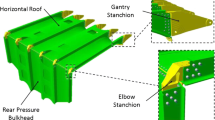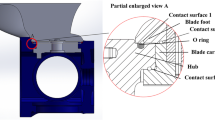Abstract
The aeronautic manufacturing industry has been seeking to enhance competitiveness and product quality by applying the Industry 4.0’s technologies. Particularly, on the roadmap of the digital twin era, a way to achieve a reduction in manufacturing time and thus production cost is to obtain prediction models of the main elementary assembly operations and functions within aircraft manufacturing process, such as the clamping force applied by the temporary fasteners on the aircraft’s structural parts. Besides being a mandatory operation, it affects multiple tasks along the product’s assembly lifecycle. This work focuses on the role of the clamping force in the assembly process, establishing its functional model by means of an experimental approach based upon resources used on a real shop floor of a major aircraft manufacturer. To evince the main requirements that the clamping force tools can achieve, this work employs the Taguchi Design method, design of experiments, and process capability analysis. The model resulted from the aforementioned methods and tools allows the assembly behavior prediction and thus the control of the manufacturing process, ultimately yielding a better geometry quality.


















Similar content being viewed by others
Data availability
All data generated or analyzed during this study are included in this published article.
Code availability
The code generated to analyze the data and create the model was attached on the submission.
Abbreviations
- ANOVA:
-
Analysis of variance
- CFA:
-
Control factor
- Cp:
-
Process capability ratio
- Cpk:
-
Process capability ratio that considers the process centering
- DOE:
-
Design of experiment
- FEA:
-
Finite element analysis
- NFA:
-
Noise factor
- LSL:
-
Lower specification limits
- PM:
-
Performance measurements
- S/N:
-
Signal-to-noise ratio
- SPE:
-
Speed rotation (RPM)
- TEMP1:
-
Low-temperature range in °C
- TEMP2:
-
High-temperature range in °C
- TF:
-
Temporary fasteners
- TOR:
-
Torque (Nm)
- TPM:
-
Total productive maintenance
- USL:
-
Upper specification limits
References
Kolberg D, Zuhlke D (2015) Lean automation enabled by industry 4.0 technologies. IFAC-PapersOnLine 48(3):1870–1875
Wang Y, Ma H-S, Yang J-H, Wang K-S (2017) Industry 40: a way from mass customization to mass personalization production. Adv Manuf, Shanghai University and Springer-Verlag GmbH Germany 5:311–320
Dalenogare L, Benitez G, Ayala N, Frank A (2018) The expected contribution of industry 4.0 technologies for industrial performance. Int J Prod Econ 204:383–394
Schleich B et al (2018) Geometrical variations management 4.0: towards next generation geometry assurance. Procedia CIRP 75:3–10
Campbell JR, Flake C (2011) Manufacturing technology for aerospace structural materials. Elsevier
Mello, JMG de (2009) Proposal Method to improve the composite assembly material production flow by the lean manufacturing approach (in portuguese). Master Degree Thesis – Aeronautics Institute of Tecnology. São José dos Campos, SP, Brasil, p 102. Internet access: http://bdtd.ibict.br/vufind/Record/ITA_834a9bc4c87153852acb7ff43ec70241/Description
Kihlman H (2005) Affordable automation for airframe assembly: developing of key enabling technologies. Doctoral Thesis. Linköping University Electronic Press. Internet access: https://www.diva-portal.org/smash/record.jsf?pid=diva2%3A471441&dswid=1695
Sarh B (1998) Wing structural assembly methodology. SAE transactions, pp 1272–1289
Boldt J (1991) Clamping technology vital to productivity. Tool Prod 57(8):29–36
Sisco T (2003) Achieving “one up assembly” by reduction of interface burr height in aluminum, graphite, and advanced titanium/graphite hybrid (TiGr) material. Aerospace Manufacturing Technology Conference & Exposition
Devlieg R, Feikert E (2008) One-up assembly with robots; Aerospace Manufacturing and Automated Fastening Conference & Exhibition. https://doi.org/10.4271/2008-01-2297
Prat P, Gueydon E (2011) Cooperative robots for full automation. SAE Technical Paper. https://doi.org/10.4271/2011-01-2536
dos Santos CR (2011) The use of sealants in the aeronautic industry. Eng Res: Tech Rep 2(2)
https://www.infomoney.com.br/mercados/a-embraer-conseguiu-fazer-a-virada-diz-presidente-da-empresa/amp/. Accessed 05 June 2022
Zanatta CV, Villani E, de Mello JMG et al (2022) Riveting process simulation to predict induced deformations in aeronautical structures. Int J Adv Manuf Technol. https://doi.org/10.1007/s00170-022-09247-4
Saadat M, Sim R, Najafi F (2007) Prediction of geometrical variations in Airbus wingbox assembly. Assem Autom. https://doi.org/10.1108/01445150710827104
Yoshizato A (2020) Prediction and minimization of excessive distortions and residual stresses in compliant assembled structures (Master dissertation). Internet access: http://dspace.library.uvic.ca/handle/1828/11776
Wärmefjord K et al (2016) Joining in nonrigid variation simulation. Computer-aided Technologies–Applications in Engineering and Medicine. https://doi.org/10.5772/65851
Faishal, KAUM (2006) Impact of riveting sequence, pitch and gap between sheets on quality of riveted lap joints (Doctoral dissertation). Internet access: https://soar.wichita.edu/handle/10057/645
Raghu A, Melkote SN (2004) Analysis of the effects of fixture clamping sequence on part location errors. Int J Mach Tools Manuf 44(4):373–382
Horn WJ, Schmitt RR (1994) Influence of clamp-up force on the strength of bolted composite joints. AIAA J 32(3):665–667
Smith SO, Mcclure T (2009) New blind, doweling, temporary fastener design and testing. SAE Technical Paper
Pritz K, Etzel B, Wei Z (2016) Automatic temporary fastener installation system for wingbox assembly. SAE Int J Aerosp 9(2016-01–2085):181–184
Webb P, Eastwood S, Jayaweera N, Chen Y (2005) Automated aerostructure assembly. Ind Rob: An Int J 32:383–387
Tian W, Hu J, Liao W, Bu Y, Zhang L (2016) Formation of interlayer gap and control of interlayer burr in dry drilling of stacked aluminum alloy plates. Chin J Aeronaut 29(1):283–291
Vichare P, Martin O, Jamshidi J (2014) Dimensional management for aerospace assemblies: framework implementation with case-based scenarios for simulation and measurement of in-process assembly variations. Int J Adv Manuf Technol 70:215–225. https://doi.org/10.1007/s00170-013-5262-9
Pilný L et al (2012) Hole quality and burr reduction in drilling aluminium sheets. CIRP J Manuf Sci Technol 5(2):102–107
Barton E (2016) High performance motion control without a foundation for fuselage fastening automation. SAE Technical Paper
Dillhoefer T, Erdinc F (2017) CPAC bulkhead riveting system. SAE Technical Paper
Bigoney B (2019) Automatic drilling and fastening system for large aircraft doors. SAE Technical Paper
Sarh B (2002) Use of electromagnetic and vacuum forces on aircraft assembly. SAE Technical Paper
Dillhoefer T, Orourke B (2007) All electric fastening system (AEFS). SAE Transactions, pp 724–732
Barton E, Wolf R (2017) Drivmatic® automatic fastening system with single robot positioner. SAE Technical Paper
Sarh B, Logan T, Stanley D (2002) Method for installing fasteners in a workpiece. U.S. Patent 6,357,101, 19. Internet access: https://patents.google.com/patent/US6357101B1/en
de Oliveira AR et al (2015) Stabilization devices and methods for component assembly, especially aircraft component assembly. U.S. Patent Application 14/264,209, 29 out. Internet access: https://patentimages.storage.googleapis.com/4a/61/89/9f68aa5902ef84/US10005565.pdf
Fei CAI et al (2018) One up assembly aircraft panel drilling system. U.S. Patent Application 15/333,915, 26 abr. Internet access: https://patentimages.storage.googleapis.com/37/49/22/5a68b6761d9da1/US11370036.pdf
Mello JMG et al (2020) A novel jigless process applied to a robotic cell for aircraft structural assembly. Int J Adv Manuf Technol 109(3):1177–1187
Chouvion B et al (2011) Interface management in wing-box assembly 2011–01–2640. https://doi.org/10.4271/2011-01-2640
Scapa I, Thomas HL (2013) Hole-filling three-prong temporary fastener.U.S. Patent No. 8,534,651
Negroni DY, Trabasso LG (2015) Process for joining aircraft structural components. U.S. Patent n. 9,102,019, 11 ago. Internet access: https://patentimages.storage.googleapis.com/24/10/80/41787f69454115/US9102019.pdf
Zhang W et al (2021) Optimisation for clamping force of aircraft composite structure assembly considering form defects and part deformations. Adv Mech Eng 13(4):1687814021995703
Oskouei RH, Mehdi K, Constantinos S (2009) Estimating clamping pressure distribution and stiffness in aircraft bolted joints by finite-element analysis. Proc Inst Mech Eng, Part G: J Aerosp Eng 223(7):863–871
Rezaei AA, Wärmefjord K, Söderberg R et al (2020) Optimal design of fixture layouts for compliant sheet metal assemblies. Int J Adv Manuf Technol 110:2181–2201. https://doi.org/10.1007/s00170-020-05954-y
Lindkvist L, Carlson JS, Söderberg R (2005) Virtual locator trimming in pre-production: rigid and non-rigid analysis. ASME 2005 International Mechanical Engineering Congress and Exposition, pp 561–568
Germer C, Nagat M, Klenk T (2014) Die virtuelle Messdatenanalyse bei Volkswagen. Konstruktion 66(10):94–98
Keller C (2014) Force-controlled adjustment of car body fixtures”. Procedia CIRP 23(C):89–97
Keller C, Putz M (2016) Force-controlled adjustment of car body fixtures - verification and performance of the new approach. Procedia CIRP 44:359–364
Bergström P, Fergusson M, Sjödahl M (2018) Virtual projective shape matching in targetless CAD-based close-range photogrammetry for efficient estimation of specific deviations. Opt Eng 57(5):053110. https://doi.org/10.1117/1.OE.57.5.053110
Zhuang C, Liu J, Xiong H (2018) Digital twin-based smart production management and control framework for the complex product assembly shopfloor. Int J Adv Manuf Technol 96(1):1149–1163
Rezaei Aderiani A et al (2019) Individualizing locator adjustments of assembly fixtures using a digital twin. J Comput Inf Sci Eng 19(4). https://doi.org/10.1115/1.4043529
Tao F, Cheng J, Qi Q, Zhang M, Zhang H, Sui F (2018) Digital twin-driven product design, manufacturing and service with big data. Int J Adv Manuf Technol 94(9):3563–3576
Tao F, Zhang M (2017) Digital twin shop-floor: a new shop-floor paradigm towards smart manufacturing. IEEE Access 5:20418–20427
Nunes JAF, Trabasso LG (2022). Riveting Squeezing Force Estimation: A Revised Algebraic Model. J Aircr 1–15. https://doi.org/10.2514/1.C036635
Logothetis N, Wynn HP (1989) Quality through design: experimental design, off-line quality control, and Taguchi’s contributions. Clarendon Press, Oxford, U.K, pp 242–250
Montgomery DC (2009) Design and analysis of experiments . John wiley & sons.
Karna SK et al (2012) An overview on Taguchi method. Int J Eng Math Sci 1(1):1–7
Montgomery DC (2020) Introduction to statistical quality control. John Wiley & Sons
Bi S, Liang J (2011) Robotic drilling system for titanium structures. Int J Adv Manuf Technol 54(5–8):767–774
Skorupa A, Skorupa M (2012) Riveted lap joints in aircraft fuselage: design, analysis and properties, vol 189. Springer Science & Business Media, p 268. https://doi.org/10.1007/978-94-007-4282-6
Author information
Authors and Affiliations
Contributions
All authors (J. M., L. T., A. S., and W. O) contributed to the research proposal, design, and execution. Material preparation, data collection, and analysis were performed by J. M. The first draft of the manuscript was written by J. M. and all authors commented on previous versions of the manuscript. All authors read and approved the final manuscript.
Corresponding author
Ethics declarations
Ethics approval
Not applicable.
Consent to participate and publish
The authors declare that they consented to participate and publish this research.
Competing interests
The authors declare no competing interests.
Additional information
Publisher's note
Springer Nature remains neutral with regard to jurisdictional claims in published maps and institutional affiliations.
Rights and permissions
Springer Nature or its licensor (e.g. a society or other partner) holds exclusive rights to this article under a publishing agreement with the author(s) or other rightsholder(s); author self-archiving of the accepted manuscript version of this article is solely governed by the terms of such publishing agreement and applicable law.
About this article
Cite this article
de Mello, J.M.G., Trabasso, L.G., Silva, A.V.S. et al. Clamping force model application on the aircraft structural assembly. Int J Adv Manuf Technol 124, 1951–1969 (2023). https://doi.org/10.1007/s00170-022-10555-y
Received:
Accepted:
Published:
Issue Date:
DOI: https://doi.org/10.1007/s00170-022-10555-y




